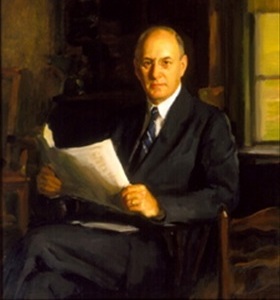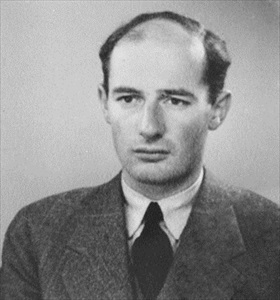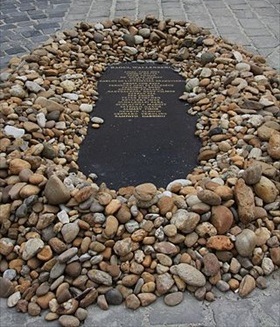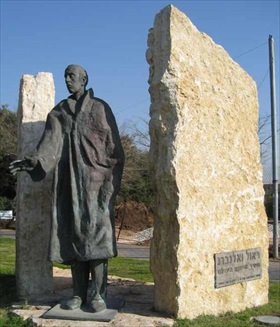AGENCY TO RESCUE JEWS, OTHERS
Washington, D.C. · January 22, 1944
On this date in 1944 President Franklin D. Roosevelt signed Executive Order 9417, which created the War Refugee Board (WRB). The president said that “it was urgent that action be taken at once to forestall the plan of the Nazis to exterminate all the Jews and other persecuted minorities in Europe.” Board commissioners, among them three cabinet members, were charged with aiding and rescuing persecuted racial, religious, or political “minorities” who were “civilian victims of enemy savagery.” Leading the WRB was the Assistant Treasury Secretary, who reported directly to the president. The immediate cause for Roosevelt’s executive action was pressure from the Treasury Department, which had been stymied by some State Department personnel who objected to charitable groups like the World Jewish Congress using funds regulated under the Trading with the Enemy Act to pay for food, medicine, transportation, and other aid to refugees and other victims of the war in Europe, including detainees in German concentration camps. The WRB enlisted the help of foreign governments and international refugee and rescue organizations like the International Red Cross and the United Nations Relief and Rehabilitation Administration in carrying out its functions. Through the board’s efforts, refugee camps were set up in North Africa, and safe havens were arranged in Palestine, Switzerland, and Sweden. By the end of the war in 1945 perhaps as many as 200,000 Jews had been rescued by the WRB. About 15,000 Jews and more than 20,000 non-Jews had been evacuated from Nazi domains. At the very least, about 10,000 Jews were protected within Nazi-controlled territory by resistance groups funded by the WRB. The board removed 48,000 Jews living in the borderlands of Ukraine and Romania to safety inside Romania. About 120,000 Hungarian Jews also survived owing in part to WRB’s activities, which funded the efforts of Raoul Wallenberg, Sweden’s fearless special envoy to Budapest, among others. At the conclusion of the war the board was abolished, its work, in the words of its first executive director, being “too little, too late” to save the 37–54 million civilians who perished due to military action or crimes against humanity.
[amazon_carousel widget_type=”ASINList” width=”600″ height=”200″ title=”Recommended Reading” market_place=”US” shuffle_products=”False” show_border=”False” asin=”0618507558,0763629766,0674050266,0306815575,0814330959,1611453372,0615887694,1470193701,1569803110,0853037272″ /]
Two Principals in the Attempt to Save European Jewry from Nazi Extermination
 |  |
Left: As U.S. Secretary of the Treasury during the Roosevelt administration, Henry Morgenthau, Jr. (1891–1967) played a major role in designing and financing the New Deal. He was a central figure in financing U.S. participation in World War II, shaping foreign policy (for example, Lend-Lease and support for China), and helping Jewish refugees escape Nazi extermination. Created largely at the behest of Morgenthau, the U.S. War Refugee Board was the first major attempt by the United States to deal with the annihilation of European Jews, and it sponsored Raoul Wallenberg’s mission to Budapest.
![]()
Right: Swedish businessman, diplomat, and humanitarian Raoul Wallenberg (1912–1947?) is widely honored for his successful efforts to rescue tens of thousands to as many as one hundred thousand Jews from Hungarian Fascists and the Nazis in German-occupied Hungary during the later stages of the war. While serving as a special envoy in Sweden’s Budapest embassy between July and December 1944, Wallenberg issued protective passports that identified their owners as Swedish citizens. Incredibly, they were recognized as legitimate documents by Hungarian and German authorities. More incredibly, Wallenberg managed to shelter and feed Jews in safe houses in Budapest’s Jewish ghetto (buildings identified as Swedish territory right down to Swedish flags affixed to the outside walls!), thereby saving tens of thousands of Jews from certain death. At the height of the Soviet siege of Budapest on January 17, 1945, Wallenberg disappeared during a visit to Red Army headquarters.
 |  |
Left: Hungary named Wallenberg as an honorary citizen in 2003. Several sites honor him, including this one in the Raoul Wallenberg Memorial Park at the Dohány Street Synagogue in Budapest.
![]()
Right: The Raoul Wallenberg Memorial, Wallenberg St., Tel Aviv. Israel granted Wallenberg honorary citizenship in 1986 and honored him at the Yad Vashem memorial in Jerusalem as one of the Righteous Among the Nations, a designation that recognizes Gentiles who saved Jews during the Holocaust. The U.S. Congress made Wallenberg an Honorary Citizen of the United States in 1981, the second person after Winston Churchill to be so honored.
Tribute to Raoul Wallenberg, 1912–1947?
![]()

 History buffs, there is good news! The Daily Chronicles of World War II is now available as an ebook for $4.99 on Amazon.com. Containing a year’s worth of dated entries from this website, the ebook brings the story of this tumultuous era to life in a compelling, authoritative, and succinct manner. Featuring inventive navigation aids, the ebook enables readers to instantly move forward or backward by month and date to different dated entries. Simple and elegant! Click
History buffs, there is good news! The Daily Chronicles of World War II is now available as an ebook for $4.99 on Amazon.com. Containing a year’s worth of dated entries from this website, the ebook brings the story of this tumultuous era to life in a compelling, authoritative, and succinct manner. Featuring inventive navigation aids, the ebook enables readers to instantly move forward or backward by month and date to different dated entries. Simple and elegant! Click 











